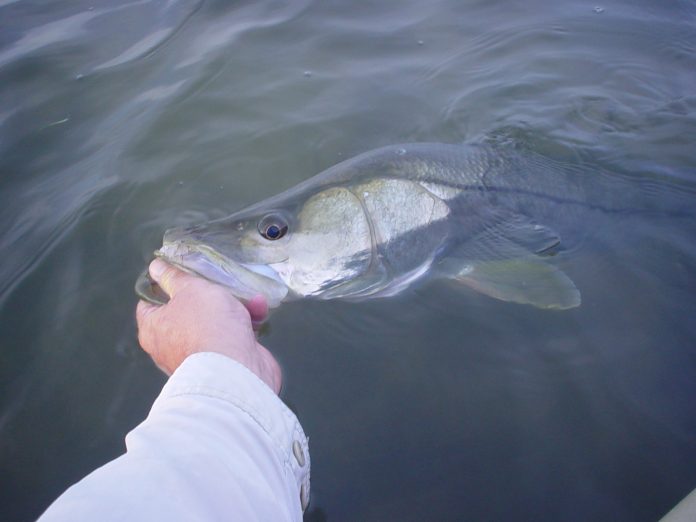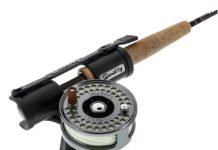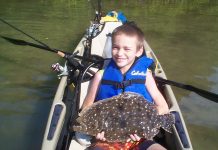 By Neil Taylor
By Neil Taylor
Fishing Guide, www.strikethreekayakfishing.com
Owner and administrator: www.capmel.com
A topic of great interest to Gulf coast anglers and fishing guides since they became aware that an executive order would be allowed to expire, considerable efforts were made to get the Commission to reconsider the decision. The evolution of this interaction is summarized below.
The Meeting:
A meeting on June 30, 2013 was set up by an FWC fisheries administrator to discuss the oppositions to the reopening of snook to harvest. Attending were FWC biologists, administrator Luiz Barbieri and a regional director with the commission. I was there along with Manatee County fishing guide Captain Rachel Cato Nobbe.
The meeting came about after interaction between the fishing community and the state, spurred on after people were surprised that the executive order was not extended. The vocal protests of the decision to let the executive order keeping snook closed was something that was very prevalent with the general fishing community and the fishing guides. The people are still stymied on this situation because they cannot quite grasp why this is even being considered.
The progress of the meeting was positive. The explanations given on science were what we already knew about the program. The misunderstandings and some communication deficiencies were also discussed. The attempts to correct these things moving forward will be addressed and future meetings are being organized. The options for moving forward were discussed. Barbieri explained the commission process and inner workings. We emphatically expressed our concerns that we do not feel that public input was incorporated into this decision.
Among the many opinions expressed, the scientists, who very thoroughly know their program and material-, gave scientific responses to various observations by Captain Rachel and me. We do not challenge their science. We have some serious concerns about some of the things that are included in their deductions. Particularly how many people release slot-size fish. Three and a half years of closure of the species, the euphoria over a state announced re-opening of the species could create an unprecedented “gold rush” on the species, an angler behavior that possesses much uncertainty. It is a certain risk to a population of fish that could see an icy exodus thinning out numbers fast. Without a doubt, we also made a big point of saying that none of the professional guides, none of them, who are our contemporaries, were ever asked anything about this species. Following such a brutal catastrophic event the 2010 freeze, we feel it is not good that the people who know the real data on hard numbers of snook do not want to see the benefits of years of closure erased by what “opening to harvest” will mean for this species. What it comes down to: Just because their science says that the species can endure harvest, does not mean that this is neither “right” nor what the people want.
Different points of view, many times it came back to Science versus size and numbers of snook. My own situation expressed clearly, I have not taken snook trips since 2009. I will not until I have fish in numbers to be targeted again. In an ancillary comment, I expressed the economic side of this situation. So many of my clients do not fly down, stay in hotels, and buy their fishing licenses to go fishing for other species. The delays that the exposure of the species to extra fishing and harvest pressure could farther delay the recovery process of a stabilized snook fishery. Moreover, it came back a few times that I do not have clients for snook by my decision, translating to a lot of my clients who do not visit Florida something that has nothing to do with “being able to keep a snook.”
Lots of concepts like the amount of total fishing pressure catch and release principles and other significant things- Captain Rachel and I made it clear “don’t go by what we say” and suggested that they seriously consider gathering the feedback from the public.
All parties agreed that subsequent meetings should be held with the inclusion of other entities so that they may hear out the other side and ask questions.
After the Meeting:
The discussions to set up a subsequent meeting met with some obstacles: Our insistence that the ruling is a mistake colliding with a decision that has already been made. The commission structure and process, their focus is on the topics for their next meeting (in September) we did not get a direct conference with the commissioners. But, we have been heard. The regional director spent almost two full hours on the phone with me.
In painstaking detail, we went through the agency’s process in resource management and we argued our case for keeping the species of snook closed. The biggest obstacle was really that the decision had already been made. The arguments still exist on several fronts and despite almost no one being in support of it in the real world, this species is reopening to harvest September 1st. But there are opportunities that did not previously exist, which is positive
For certain, a major deficiency in the process was input. We met criticism for that when it came up during the very first meeting but as we kept the communication lines open, it became apparent that they had to acknowledge that they did not have the input that we generated inside the fishing community. We expressed it very plainly that there is a big problem with apathy amongst the fishing community when it comes to FWC resource lawmaking decisions. The example that was cited was the 2011 Redfish Workshops and the outcome of that species regulation change that went through anyway. We disputed that they openly sought public input on the topic of reopening snook to harvest.
What happens next?
The bigger gain to be identified and cultivated: the opportunity to reenergize a snook forum. Previous snook symposiums were mentioned, but the most recent one distant history, we all agreed that should be cultivated. A thing of the past, bringing the stakeholders into the process can only be helpful for getting everyone on the same page, eliminating these contentious debates every time a rule change is announced.
A huge need, revising “Management goals” from what they currently are. Science is important but stating the obvious, it does not justify this decision in the opinion of the most knowledgeable “on the water.” Debating the criteria and setting rules to go by, different decisions may be made. This decision, by my personal calculations, was made to accommodate about 2% of the fishing population. There is about 15% that is undecided and the remainder would rather see this species return to prominence faster by continuing the closure. Another concept that was ignored in this decision process: Economics. I have clients who are only interested in catching snook. I have not taken a snook trip since 2009. The delay in bringing this species back to prominence hurts everyone (including me). I counted 15 of my out-of-state clients who have not visited since before the freeze. That’s all lost revenue for the rental car companies, hotels, restaurants. I am not alone in discouraging the targeting of snook. Guides want people to catch fish. What does it say that a captain like Scott Moore is taking redfish charters? It speaks volumes.
They have to have something to work from. A new goal is to have more input on what these criteria are. Spawning potential ratios, while a nifty concept, ignores real numbers. Real numbers are a matter of opinion but as I argued in the meeting and in conversations since the meeting, their original estimate on the number of fish lost did not properly reflect what happened that fateful January stretch in 2010. It wasn’t a whittle down, it was a massacre. The recovery and percentages listed, also a matter of opinion and vary from region to region. I do not believe we have 20% of the fish we had in 2009. Other guides support that estimate even in other areas of the Gulf coast.
Where do we go from here? That has been asked repeatedly. We go upward and onward. We had discussed rally type gatherings to show the support for extending the closure. The reality, while visible, it is not going to do anything at this time. While so many of my colleagues would like to see a miracle happen and have the decision changed, there is another route to go, even though it will not achieve what we had hoped we would get done when this started. We need to reach out to the community and ask people if they would release all the snook that they catch. We need to try to teach people improved handling techniques and ways to minimize mortality of snook. We need to train people how to effectively report poachers and help the field officers put a stop to the illegal take of our resource. We need to network together so the officials know your input before it is decision time.
This is painful for so many to accept but an effort to minimize the damage by personal choices overcomes harvest rules. By all means, if you disagree with something, keep speaking up. But be a part of the solution too: If you do not feel that the species has recovered, do not keep a snook. It sounds so simple but I had people tell me they did not support the decision but if snook do reopen if they catch one that is legal to keep, they would. That is mystifying and disheartening. If you convince your friends then maybe snook will not be targeted as hard period. That is actually the best case scenario. So many of us are more concerned about the excessive pressure of fishing the species that “opening” creates. We won’t stop everyone from targeting snook. But the people who are, what are their skills?
Fish handling for catch-and-release is a concept that has helped to improve the fishery over the past decade. It has caught on so much better for one specific reason: No one can argue against it. Who wouldn’t want a fish to have the best chance at surviving that encounter? Snook, played too long, handled badly, kept out of the water too long obviously have a lower chance for survival. We can all make an extra effort to educate those who do not know these concepts and techniques benefitting all species. I have been asked by the Snook Foundation to supply them with a release techniques article, something I will gladly do because it is a great topic. But never anywhere near as important as it is now.
We hoped to have an announcement “Snook will remain closed!” It didn’t work out that way. Disappointed? Absolutely, deeply. Giving this news to so many concerned anglers, they are alarmed. The decision here is something that is widely opposed. The outcome is that things will become better than they were. We could opt to waste a lot of energy to do things that will not accomplish anything or change angles. Holding tightly to the shared philosophy “there is nothing good that can come from this decision” as it relates to this species, I have not given up but that will not stop the species from re-opening on September 1st. What we can hope: they never make a decision like this without talking to us and that people are wise enough to realize that if they would like to see this fishery anywhere near what it was in 2009, maybe we should just leave them alone a while longer, no matter what the Florida state regulations say.
Neil Taylor is the owner and guide at Strike Three Kayak Fishing, owner of www.capmel.com, outdoor writer and speaker.

- The Neil Blog… - July 26, 2023
- The Catfish - July 26, 2023
- update - July 22, 2023











